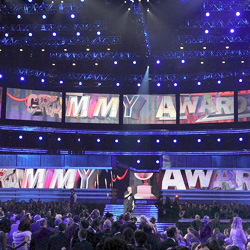
Global Template
Fletch also took me to Michael Parker’s world, where he mixes monitors for the B stage artists from his PM1D positioned on an arena concourse above and to the side of the front platform.
He and Tom Pesa, stationed directly across on the A stage side, seamlessly trade-off on monitor mix duties throughout the show.
Parker also specializes in TV work, arriving on the scene in the late 1990s after more than 15 years on the road, where he worked his way up from volunteering to do “anything and everything” to get his foot in the door at LA live clubs like the Troubadour in the early 1980s to mixing a wide range of top artists, including a who’s who of R&B legends such as Smokey Robinson, Dianna Ross, Whitney Houston and others.
For the Grammys, he and Pesa have developed and evolved a “global template” that serves as their monitor mix baseline, and then they merge in specific adjustments for each artist as well as the show’s production elements to create specific scenes. Like his mix mates, Parker is also quite satisfied with the PM1D platform for this show.
“From a monitor point of view, the PM1D is still one of the faster consoles out there,” he says. “The way it’s laid out with 24 outputs on one page and 56 inputs on one page is quite a bit.”
“The trend now is to smaller consoles, but that means you have to scroll though more to get where you need to go, so with the PM1D, it’s all there and pretty accessible in a quick way.”
This year, eight stereo RF IEM systems were available for artists, along with eight stereo hardwired IEM systems. These 16 stereo mixes for IEM cover almost everything needed, Parker notes, and then there are several floor monitors downstage that are concealed in the stage for use by any artists wishing to do so.
Parker and Pesa work with the stage manager to get these placed as optimally as possible, but again, it involves compromise because the TV picture drives the production.
“These days most of the artists are on IEM, but we usually have nine more mixes via the floor monitors available,” Parker says. One unique aspect this year was Bob Dylan, who preferred side fill only for monitoring. These cabinets were simply put into place and patched in for his performance only.
The Bigger Picture
Microphones are the choice of each individual artist, and there’s a wide range of wired and wireless microphones from Shure, Audio-Technica, AKG, Sennheiser, Audix and many others on hand.
Several of these companies have a representative on hand throughout rehearsals and the show to be sure all of their respective artists needs are being served. The wireless microphone situation is managed by Dave Bellamy of Soundtronics of Burbank, CA, assisted by Grant Greene, posted with the system receivers in an area just outside the arena bowl.
Parker points out that one of the biggest aspects of his and Pesa’s gig is fostering a comfort factor and rapport with all of the various engineers on site, working in the interest of their artists.
“Some of them haven’t done TV work, so it’s imperative that we take the time to explain to them how this all works, the setup and layout, to help bring them into the fold,” Parker says.
“We address their issues and concerns as much as possible within the format of the bigger picture so that they can relax, because if they’re relaxed, then their artists are going to relax, and that’s going to help result in the best performances. It’s unseen, but is really one of the most important parts of the gig.”
This year, artists such as Barbra Streisand, Arcade Fire, Eminem and several others were his responsibility, and it all went off very well. “There was nothing out of the ordinary, which is good news,” he says.
“The Aretha Franklin medley that kicked off the show really sounded good to me this year – those ladies really brought their A game – and that set the pace.”
Grammy Awards Audio Production Team
Michael Abbott, audio coordinator
ATK Audiotek, live sound company
Mike Stahl, president, ATK Audiotek
Scott Harmala, CTO/VP engineering, ATK Audiotek
Ron Reaves & Mikael Stewart, live front of house mix
Michael Parker & Tom Pesa, live house monitor mix
Andrew “Fletch” Fletcher & Jeff Peterson, live system managers/techs
Dave Bellamy (Soundtronics), RF frequency coordination
Bill Kappelman, RF microphones manager
Steve Anderson, “split world” manager
Leslie Ann Jones (The Recording Academy), house audio supervisor
M3 (Music Mix Mobile), broadcast music mix
Joel Singer (M3), engineer in charge, Eclipse mix truck
Mark Linett (M3), engineer in charge, Horizon remix truck
John Harris & Eric Schilling, broadcast music mixers
Tom Holmes, overall broadcast mix
Phil Ramone & Hank Neuberger, broadcast audio supervisors
Keith Clark is editor in chief of Live Sound International and ProSoundWeb
